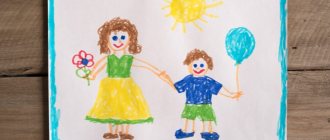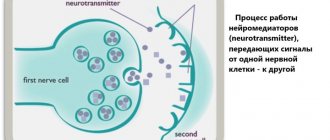One of the most common conditions in young children is hyperactivity. This diagnosis is most common among preschool children, but older children can also be susceptible to the disease. An overly active child is poorly socialized and has difficulty learning. It is difficult for him to establish relationships with peers and concentrate on gaining knowledge. The pathology may be accompanied by other nervous diseases.
Childhood hyperactivity is observed in attention deficit hyperactivity disorder (ADHD). Pathology is a disruption of the normal functioning of the brain, which leads to severe nervous tension.
Why is this a problem
Adults usually do not pay attention to the child’s behavior, believing that he will “outgrow” with age. And they turn to a doctor only when the problem simply cannot be ignored.
In kindergarten, the problem is just beginning to develop. But when the child goes to school, the signs begin to be expressed more clearly. The educational process requires organization of classes, that is, this is exactly what the baby is not prepared for. Poor concentration, active mobility and inappropriate behavior in class make a full-fledged educational process impossible.
Children with increased activity constantly need the supervision of a teacher, since it is very difficult to focus the child’s attention on the educational process, he is constantly engaged in extraneous matters, is distracted, and lacks attention. The teacher's patience and experience are often not enough to correct destructive behavior. A reverse reaction begins to form—aggression.
The development of such children lags behind their classmates. Teachers cannot adapt to the developing pathology, this leads to conflicts. A hyperactive child at school is often subject to bullying by peers, and he develops problems with communication. They don’t want to be friends with him; this causes resentment, attacks of assault, and aggression.
The tendency to lead due to the impossibility of being one begins to give rise to the development of low self-esteem. After a certain time, isolation develops. Psychological problems appear more pronounced.
Many parents are frightened by this diagnosis. They may believe that their child is developmentally delayed. This is a wrong opinion, because in fact a hyperactive baby:
- Creative. He has many interesting ideas, and his imagination is very rich. If mom and dad help the child, in the future he will be able to become a wonderful specialist with a creative approach to business or a representative of a creative profession with multifaceted interests.
- He has a flexible mind, is distinguished by enthusiasm and the ability to find solutions to complex problems. He is versatile, has many interests, and strives to be the center of attention.
- Energetic and unpredictable. This property can be both beneficial and negative. The baby has a lot of strength for different activities, but it can be almost impossible to keep him in place.
There is an opinion that a hyperactive baby is always on the move and moves chaotically. This is not entirely true. If any activity absorbs all the attention of a preschooler, he may forget about everything else. It is important for parents to encourage hobbies by allowing them to choose what to do.
The symptoms of hyperactivity in a child and his intellectual abilities are in no way connected. Very often these guys are very talented. In addition to treatment, they need to be educated, kept within clear boundaries, trying to develop their natural abilities. They often dance, sing, and perform in public wonderfully.
Complex post-traumatic stress disorder
Post-traumatic stress disorder (PTSD) is an extreme psychobiological reaction of a child's psyche to a traumatic event or events, characterized by significant impairments in cognitive, affective, behavioral and physiological functioning. Hyperarousal is one of the main symptoms of post-traumatic stress disorder. Symptoms of hyperarousal include irritability or aggression, risk-taking or destructive behavior, hypervigilance, increased startle response, difficulty concentrating, and difficulty sleeping.
Chronic exposure to psychological trauma and life adversity (cruelty, violence, inattention, neglect, failure to meet basic life needs), which plays a role in the development of complex PTSD in children, leads to chronic hyperarousal of the hypothalamic-pituitary-adrenal axis, which causes negative changes in the development of the child's brain . Research findings suggest that the stress response system can become either chronically overactive or underresponsive over time. Dysregulation of the stress response system is associated with changes in the development of key brain structures, such as the hippocampus. The amygdala, an area of the brain associated with automatic (preconscious) processing of emotional information, in these children demonstrates an excessive reaction to significant, especially threatening, emotional stimuli. Hyperarousal in traumatized children has a unique protective function, preparing them for a real or imaginary threat. PTSD in children is very often comorbid with ADHD. Adults diagnosed with ADHD as children were 50% more likely to experience trauma and stress disorders than those who did not have ADHD.
Causes of hyperactivity in children
Increased excitability is usually observed in children whose parents have a choleric character. Children, as a rule, only copy behavior in a more pronounced form.
If we consider the signs of hyperactivity in a child under one year old, there is a clear tendency towards a genetic predisposition for the transmission of this pathology. Approximately 45% of parents of hyperactive children suffered from this condition in childhood.
In most cases, disruptions in brain activity begin in utero. The following factors can lead to the formation of pathology:
- Difficult pregnancy;
- Unhealthy lifestyle or maternal smoking while expecting a baby;
- Stress and anxiety experienced by the expectant mother;
- Intrauterine asphyxia;
- Toxicosis during gestation;
- Hypoxia.
Less commonly, the disease can arise as a result of a difficult course of labor. Its occurrence can be influenced by such phenomena as:
- Very long contractions or attempts in a woman in labor;
- Using medications to induce labor;
- The birth of a baby before 38 weeks.
In exceptional cases, hyperactivity appears for other reasons that have nothing to do with birth. Pathology can occur if the following factors are present:
- Diseases of the nervous system;
- Quarrels and frequent conflicts between parents;
- Overly strict upbringing;
- Serious chemical poisoning;
- Unhealthy eating.
The listed reasons are risk factors. Of course, it is not necessary that a difficult birth will result in a hyperactive child. If the expectant mother was often nervous and was kept in confinement, the risk of developing a problem in her baby increases.
Not every baby who behaves inappropriately is hyperkinetic. For some guys, stubbornness, disobedience, and excessive mobility are a consequence of temperament. You just need to learn how to behave with them and not punish them, as this can cause a backlash.
Fetal alcohol spectrum disorders (FASD)
The term fetal alcohol spectrum disorder (FASD) is used to describe a wide range of problems that children exposed to alcohol prenatally may experience. This condition results from parents either not being aware of the dangers of drinking alcohol during pregnancy or planning a pregnancy, or not receiving support to abstain from alcohol during pregnancy. Alcohol can harm an unborn baby at any stage of pregnancy, even before pregnancy is confirmed. The level of harm depends on a number of factors, making it impossible to predict the outcome of alcohol exposure in any individual pregnancy. Factors include the amount and frequency of alcohol consumption, parental age and maternal health (diet, tobacco use, mental health), as well as environmental factors such as stress.
The effects of FASD vary widely and it is sometimes called an "invisible disability" because often the condition goes undetected, the characteristic features (physical, developmental and/or neurobehavioral) in the FASD spectrum are rarely evident at birth unless they are accompanied by specific factors face and height, which occur infrequently. The disorder is often not noticed until the child reaches school age, when behavioral and learning difficulties become more obvious. Most children and adults with FASD live with significant cognitive, behavioral, health, and learning problems, including problems with memory, attention, reasoning, impulsivity, excitability, receptive language, and difficulties in adaptive functioning. These difficulties persist throughout life and significantly influence behavior. Positive results can be achieved if parents receive appropriate support early on so that they understand their child's behavior as a symptom of brain damage.
Symptoms of hyperactivity
The main symptoms of hyperactivity in a child under 2 years of age do not appear immediately. Until this time, he can behave quite normally. They appear gradually. The manifestation of the disease in children can be suspected if:
- During the daytime, restlessness, constant fussiness, excessive restlessness, inability to complete the task;
- Poor sleep at night - movements and sobbing in bed, anxious prolonged falling asleep, regular waking up, talking in sleep;
- Any type of work begins to cause reluctance to do them;
- Inattention, forgetfulness, periodic scattering of various objects, poor concentration;
- Failure to comply with adult requests;
- Attacks of impulsiveness, emotional instability.
It can be very difficult to distinguish attention deficit disorder from ordinary childhood restlessness. Some parents and specialists mistakenly diagnose their child, even though the child does not actually have any serious problems.
Certain symptoms may indicate neurasthenia, but you still cannot self-prescribe medications for hyperactivity in children.
If you suspect ADHD, consult a doctor. Before the age of 1 year, hyperactivity may manifest itself as follows:
- Strong excitability;
- Nervous reaction during hygiene procedures (the baby may cry during a massage or bathing);
- High sensitivity to external stimuli (sounds, light);
- Disturbed sleep patterns (frequently wakes up at night and stays awake for a long time during the day; it is very difficult to put him to sleep);
- Developmental delay (the baby may begin to crawl, walk, sit, and speak later than peers).
Up to 2-3 years of age there may be difficulties with speech. The baby is unable to form phrases and sentences for a long time. It is not diagnosed until the age of one, since these signs often appear due to teething, digestive problems or the whims of the baby.
Highly qualified psychologists around the world recognize that there is a crisis of 3 years. In attention deficit disorder it is especially acute. At this time, the baby’s parents begin to engage in socialization and take him to kindergarten.
This is when hyperactivity becomes noticeable. The child may be restless, inattentive, disobedient, and have problems with motor skills and speech. Parents may notice that it is very difficult to persuade a preschooler to go to bed.
A three-year-old feels very tired in the late afternoon. The baby cries for no apparent reason and behaves aggressively. Thus, excessive fatigue manifests itself, but the child continues to be active, talks loudly, and moves a lot.
In most cases, the diagnosis is made in children aged 4-5 years. If parents have not paid enough attention to the child’s physical and psychological health, the symptoms will become very noticeable when they start school.
Signs of hyperactivity are expressed as follows:
- Difficulty concentrating;
- Restlessness;
- During a lesson, a student may leave his place and violate discipline;
- Difficulty in understanding the teacher’s speech;
- Hot temper, aggressiveness;
- Nervous tics;
- Lack of independence;
- Frequent headaches;
- Unbalanced behavior;
- Enuresis;
- Severe anxiety.
Mother and father may note that he has problems with academic performance. Often the illness can be accompanied by conflicts with classmates. Peers avoid overly active children because it is difficult to find a common language with them, they behave aggressively and impulsively. Such guys are touchy and cannot always correctly assess the possible consequences of their behavior.
Emotional problems in children: aggression, anxiety, fears
April 25, 2021
Aggression
Increased aggressiveness in children is one of the most pressing problems not only for doctors, teachers and psychologists, but also for society as a whole. The number of children with this behavior has unfortunately been growing recently. It is especially important to help preschoolers whose aggressiveness is only in its infancy.
No other behavior irritates adults and maladjusts children as much as aggressive behavior. This is one of the few conditions when parents try to bring their child to a specialist as early as possible. Aggression manifests itself in a wide range from harsh statements to physical actions, representing that rare case when an aggressive child, instead of sympathy, causes general irritation and often retaliatory aggression from adults.
Based on numerous studies, it should be accepted that aggression is biologically inherent in humans. This is a mechanism that allowed man in very ancient times to survive among more adapted and stronger animals. Subsequently, having solved these problems, aggression did not disappear, but as man developed and society formed, it came under the control of social norms and functions.
In a structured form, aggression manifests itself in the form of aggressive behavior or aggressive actions. This is one of the forms of response to various unfavorable physical and psychological life situations.
The main causes of child aggression are:
- desire to attract the attention of adults and peers;
- the desire to get the desired result;
- the desire to be in charge;
- protection and revenge;
- the desire to infringe on the dignity of another in order to emphasize one’s superiority.
Among the psychological characteristics that provoke aggressive behavior in children, the following are usually identified:
- insufficient development of intelligence and communication skills;
- reduced level of self-regulation;
- underdevelopment of gaming activities;
- decreased self-esteem;
- disturbances in relationships with adults and peers;
- increased excitability of the nervous system due to various reasons (trauma, illness).
One of the most common mistakes of adults is the desire to suppress all manifestations of children's aggressiveness. Unfortunately, this is not only completely wrong, but even dangerous: suppressed aggression does not disappear, but accumulates in the child’s “Unconscious”. One day it breaks out in the form of a violent explosion, and usually goes to innocent people. At the same time, children's aggression causes counter-aggression in adults and peers and a vicious circle is formed, from which participants often cannot get out without the help of a specialist.
To overcome the existing problem, it is necessary to organize individual psychocorrection work, which is aimed at:
- identifying the causes of a child’s aggressive behavior;
- achieving an emotional response to aggression;
- eliminating response stereotypes, increasing self-esteem, accepting oneself and others;
- practicing communication skills in possible conflict situations (behavior correction);
- consolidation of new behavioral stereotypes in real life.
The most effective method of overcoming aggressive behavior in children is the sand therapy method. Playing with sand always arouses genuine interest in a child of any age. It allows the psychologist to quickly establish contact with the little client. The child erects his own miniature image of the world on the sand, thereby telling about himself without words. By analyzing the sand picture and the child’s story, a psychologist can diagnose the reasons for the child’s aggressive behavior without traumatic questions for him. Achieving an emotional response to aggression occurs in the sand with the help of depicting various battle scenes (playing with soldiers, medieval knights, cowboys, various animals). Also, playing with sand gives the most effective results in practicing and consolidating new communication skills, since for preschoolers play is a leading activity that helps them learn how to relate correctly to other people in real life.
At some stages of working with aggressive children, along with sand, drawing is used, which is valuable because it gives children the opportunity to express themselves non-verbally - after all, their verbal (using words) communication system is not yet sufficiently developed. Drawing allows a child to react to his emotions, to throw out aggression on paper, to give free rein to his imagination: after all, what is drawn is, to some extent, what has come true.
An equally effective way to express anger is to work with clay, whose flexibility and pliability make it suitable for meeting a wide variety of needs. Children who are very angry may vent their frustration in a variety of ways. For example, make a figurine of someone they are very angry with, and then break it. This type of creativity is one of the most visual of all types of art, which allows the psychologist to observe the child’s condition, which is quite important when working with any problem.
Anxiety
Anxiety is an individual psychological feature that consists of an increased tendency to experience anxiety in a wide variety of life situations, including those that do not encourage this.
It is necessary to distinguish anxiety from anxiety. If anxiety is an episodic manifestation of a child’s restlessness and excitement, then anxiety is a stable state. For example, a child sometimes gets excited before performing at a party - this is anxiety. If anxiety manifests itself constantly, then we can talk about anxiety.
Many psychologists believe that anxiety develops due to the presence of an internal conflict in a child, which can be caused by:
- conflicting demands made by parents, or parents and kindergarten (school);
- inadequate demands (most often excessive);
- negative demands that humiliate the child and put him in a dependent position.
A child’s anxiety largely depends on the level of anxiety of the adults around him. The authoritarian style of parental education in the family also does not contribute to the child’s inner peace.
Anxious children try to keep their problems to themselves. They are characterized by excessive anxiety, and sometimes they are afraid not of the event itself, but of its premonition. They often expect the worst. Children feel helpless and are afraid to play new games and start new activities. They have high demands on themselves and are very self-critical. Their level of self-esteem is low; such children really think that they are worse than others in everything, that they are the ugliest, stupidest, and clumsy.
Working with an anxious child usually takes a long time and is aimed at:
- increased self-esteem;
- teaching the child the ability to manage himself in specific, most worrying situations;
- to relieve muscle tension.
Since anxious children, as a rule, do not openly communicate their problems, it is extremely difficult to identify what is actually bothering the child. In solving this problem, building a sand picture will help, which does not require special skills from the baby, but is simply a game - a natural activity for this age. As a result, the child does not have the feeling that he did something wrong (there is no tension), and the psychologist receives the necessary information about the internal state of the little client. After establishing contact in the sandbox, situations that worry the baby are played out with the help of various figures. In this way, constructive ways of responding are developed, which are then reinforced in real life.
Working with clay allows you to relax, thereby helping to relieve muscle tension. Children who need to improve their self-esteem gain an extraordinary sense of “I” from using this material. This type of creativity is a good way to stimulate verbal expression of feelings in anxious children, who sometimes lack such abilities.
An equally effective way to solve the problem of child anxiety is fairytale therapy. The child, identifying himself with the hero of the fairy tale, as a result of playing his image, learns to resolve the conflict, acquiring new opportunities and abilities for himself.
Fears
One of the most common reasons why parents turn to a psychologist is the presence of constant intense fears in children. Fear is the fear of something specific. At every age, normative fears are observed, which appear gradually, as a result of the development of the intellectual sphere, imagination, etc. Every child (and adults too) has certain fears. A.I. Zakharov identified them as age-related, i.e. those that accompany the child during a certain period of development. During the transition from one period of development to another in a healthy child, some fears disappear, while others appear. If this does not happen, then anxious and suspicious traits may appear in the character of an already adult person, which will hinder his development.
Thus, if the fears are close to what a baby might be afraid of at his age, then there is no reason to worry. If there are a lot of fears, then you should pay special attention to this child. The presence of numerous fears is a sign of insufficient self-confidence and lack of adequate psychological protection, which all together adversely affects the child’s well-being, creating even greater difficulties in communicating with peers. Our task is to “remove” from the child’s psyche those fears that are already causing harm, reflected in behavior by fearfulness. Fear has one weak point: until the fear is named and told, it seems huge and unbearable to a small person, but as soon as you name the fear out loud, put it into words, it loses almost half of its significance. Parents need to understand that fear indicates the existence of a problem, tension in the little person and, most likely, this cannot be dealt with without professional help.
Working with fears is aimed at:
- establishing the cause of the child’s anxiety;
- relieving emotional stress, developing communication skills;
- developing skills to overcome conflict situations.
Sand is an invaluable assistant in the first stage of working with fears. A small child cannot yet explain what is the cause of his internal anxiety. An older preschooler or younger schoolchild is often uncomfortable admitting that he is afraid of something (“I’m already big...”). By building a sand country and telling stories about its inhabitants, a psychologist can easily determine the cause of a child’s anxiety. And then a fairy tale comes to the rescue, which not only activates imagination, develops memory, enriches vocabulary, but is also a wonderful assistant for a child’s self-expression. After all, every hero of a fairy tale - well known and loved from early childhood - can tell his own story, the story of what happened to him, what he experienced. A fairy tale helps a child calm down, relieve emotional stress, and develop skills to overcome a conflict situation.
Another way to overcome fears is to depict it. Under the guidance of a psychologist, specifying fears will help the child get rid of uncertainty and spill out what worries and torments.
Children's grief at the loss of loved ones
Children, like adults, always experience the loss of a loved one. In general, children's grief is characterized by such features as delay, hiddenness, surprise, and unevenness. The child may not show immediate grief, and the acute reaction is sometimes delayed for months. In some cases, real awareness and experience of loss comes very late and under the influence of some significant event, for example, another loss. The child may not show overt signs of grief, such as crying or verbally expressing emotions, but may show signs of hidden bereavement in the form of actions, behavior changes, and neurotic symptoms. The open expression of a child's grief sometimes turns out to be unexpected for those around him: the child was just playing, frolicking, and suddenly “breaks into tears.” It is noteworthy that in children, grief often has a wave-like character, when a surge of emotions and a stream of tears are replaced by relative calm or even animation and moments of fun. Children experience grief very unevenly and tend to express their sadness sporadically over a long period of time.
The reaction of children to the death of a loved one often remains a sealed secret for adults. It happens that a child’s reaction to a loss shocks those around him or, at a minimum, leaves them bewildered. And sometimes adults don’t even know whether the child is experiencing loss, and if so, how exactly he is experiencing it. Moreover, it is not clear how to help him.
Parents of bereaved children typically face questions such as:
- Should I tell my child about the death of a loved one or not?
- should he be included in the family mourning process and funeral arrangements or not?
- Should I take it with me to the funeral or not?
- to remember the deceased with the child or not?
Contacting a child psychologist will allow parents not only to prevent the undesirable consequences of loss for the child, but also to achieve certain positive results.
How is diagnostics carried out?
It is difficult to make an accurate diagnosis at the first visit to a professional. In order to find out the verdict for sure, observation is necessary, which can last up to 6 months. The examination is carried out by three specialists: a psychologist, a psychiatrist, and a neurologist.
Many parents are often afraid of visiting a psychiatrist. However, there is nothing to worry about, because a good doctor will be able to accurately assess the child’s condition and choose the right treatment regimen. The examination must consist of:
- Conversations with the child;
- Observing the actions of a small patient;
- Filling out the questionnaire by parents;
- Neuropsychological testing.
Based on the information received, specialists make accurate conclusions about the child’s condition. Sometimes the problem may not be hyperactivity at all, but other diseases, so in some cases a blood test, an EEG, an ECHO, or an MRI of the brain may be necessary.
Older children are offered to undergo psychological testing, which determines their abilities for logical development. After a complete examination, the specialist diagnoses the absence or presence of pathology and, if necessary, develops appropriate treatment.
In order to identify the disease in time, you will need to consult with an ophthalmologist, endocrinologist, speech therapist, or otolaryngologist. Before starting treatment for hyperactivity in preschool-age children and older children, it is necessary to wait until an accurate individual diagnosis is made. There is no need to make hasty conclusions.
School teachers often complain about overly active students. It is difficult for them to sit still and they tend to break discipline in class. In this case, the syndrome may not have any effect on memory and motor skills.
Features of treatment
There is no magic pill for attention deficit disorder. For children and school-age children, treatment for hyperactivity is always prescribed in a complex manner.
With the right choice of medication, treatment results are achieved in 95% of cases. But you will have to undergo treatment for more than one year; drug adjustments will probably be necessary at an older age.
Drug therapy involves the use of sedatives, drugs that stimulate psychological development, and also improve metabolism in the brain. For this, sleeping pills, tranquilizers, nootropics and psychostimulants are most often prescribed. In certain situations, antipsychotics and antidepressants are prescribed.
But you should not attach primary importance to drug treatment, since it only relieves symptoms and does not get rid of the cause. Also, it cannot replace the most important thing - love for the child. It is she who can cure him and subsequently give him a full life.
The most relevant recommendations for correction:
- It is not advisable for children with hyperactivity to engage in sports where competitions are held. Aerobic exercise, cycling, swimming, and skiing are acceptable.
- Communication with a psychologist. A professional will select a system to reduce anxiety and increase sociability of a young patient. Conversations will help improve self-esteem, develop speech, memory and attention. If there are serious speech disorders, classes will be held with the participation of a speech therapist.
- A visit to a psychotherapist with the whole family will help cope with the condition much faster.
- Correcting the actions of all family members, getting rid of unhealthy habits of parents, normalizing the daily routine. It is also necessary to identify possible irritating factors and reduce them as much as possible or completely eliminate them. It should be understood that a tense relationship between father and mother has a detrimental effect on the development of their children.
- Drug treatment. Doctors most often prescribe nootropic drugs and sedatives with herbal composition. However, you should treat your baby with pills only if other methods have proven ineffective. Nootropics are used to improve blood circulation in the brain and normalize metabolic processes. Taking these medications will help improve memory and attention. The course of treatment can last for a long time, since the medications have an effect no earlier than after 4-6 months.
If necessary, you can ask your doctor to recommend soothing herbs that you can drink in pure form or add to tea.
Most adults note an improvement in their children's well-being while following a gluten-free diet. Some people also benefit from eliminating starch and sucrose from their daily menu. For children with high activity, all foods that are required for brain tissue are useful: lots of legumes, nuts, protein, fruits, vegetables, olive oil, fatty fish.
You need to exclude snacks and sweets with dyes, flavor enhancers, and preservatives. Experts recommend that parents select foods to which their children do not have a personal intolerance. Why should you rotate foods and make a food diary? You should take turns removing one product from the daily menu and monitoring the child’s condition.
Doctors' recommendations
Any child who is brought to a doctor for help is an individual, therefore there are no specific rules for adjusting behavior. It is necessary to take into account all the characteristics of the character and conditions that surround the baby. But there are provisions from which it is necessary to build upon when treating and educating:
- Time control. Children with this disease are often unable to control time themselves. Therefore, it is necessary to ensure that they comply with the standards when completing tasks. The latter should be written down on paper and hung above the desk. It is necessary to promptly notice and correct the child if he is excessively shifting his attention. Calmly return to the task at hand.
- Features of prohibitions. Lack of attention and increased activity is expressed in children’s absolute denial of any prohibitions. There is one rule here: the absence of the words “impossible” and “no” in phrases. Instead, you need to construct the phrase so that it implies an action, not a prohibition. That is, instead of the phrase: “Don’t jump on the chair,” you can say: “Let’s jump together,” and put the baby on the floor, then, gradually comforting him, switch him to another type of activity.
- Specifics of implementation. The peculiarity of the pathology does not allow children to practice logical thinking. To facilitate understanding, do not overload the sentences from which you form the task.
- Sequence of tasks. The disease causes absent-mindedness in young patients. We must not forget that several tasks that you give at the same time are simply not perceived by children. Educators themselves need to monitor the dynamics of the process and the assignment of the next tasks.
Games for such preschoolers must meet several main rules.
- The first of which involves organizing a quiet phase, when you need to rethink the gameplay, and after a short break, continue the game. The main thing is to take advantage of the moment of physical fatigue before completing the gameplay and try to switch the little patient to constructive work, but in a calm tone.
- The second rule is that play time should serve as a natural physiological and emotional release. For this, the child needs appropriate space. The gameplay must unobtrusively guide it in a constructive direction.
Older children benefit from sports activities. You just need to choose the right specific sport. Some people prefer team games, others prefer individual games. In any case, you need to solve the problem of excessive excitement by redirecting energy in a constructive direction.










